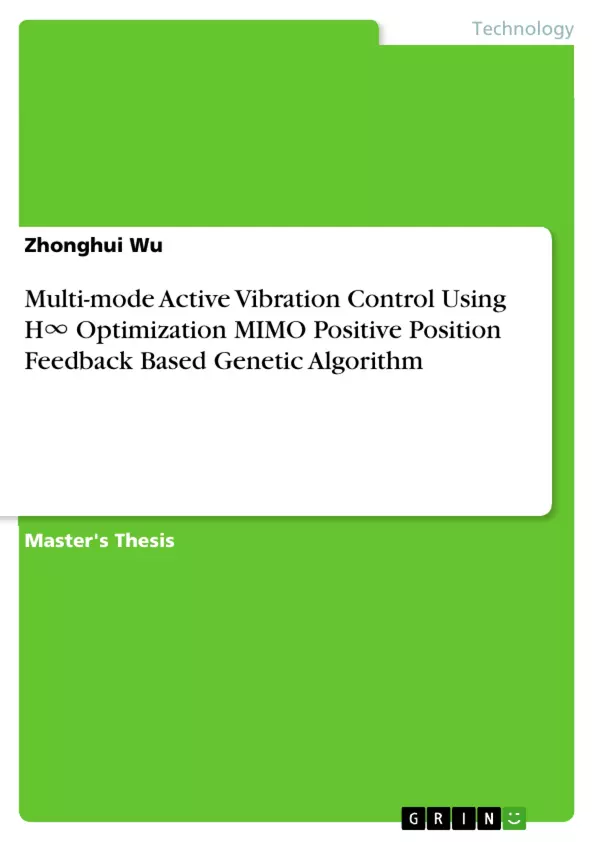
Multi-mode Active Vibration Control Using H∞ Optimization MIMO Positive Position Feedback Based Genetic Algorithm
Masterarbeit, 2014
171 Seiten
Leseprobe
Frequently asked questions
What is the main topic of this document?
This document is a comprehensive language preview concerning active vibration control, particularly focusing on modal-based controllers, positive position feedback (PPF), and their implementation on flexible plate structures. It includes the title, table of contents, objectives and key themes, chapter summaries, and keywords.
What are the key themes explored in the "Introduction" chapter (Chapter 1)?
Chapter 1 discusses the motivation for the research, the research methodology used, a literature review, the thesis outline, and a list of original contributions. It highlights the challenges in controlling flexible structures due to their distributed parameter nature, spillover effects, and the difficulty in designing wide-band controllers.
What is the experimental plant described in Chapter 2?
Chapter 2 describes an experimental plant consisting of a flexible aluminum plate mounted on an MDF board using three electromagnetic transducers, with another transducer acting as a disturbance shaker. The chapter details the physical characteristics, mechanical parameters, and electrical parameters of the transducers used.
What modeling techniques are used in Chapter 2?
Chapter 2 uses analytical analysis, experimental measurements, and numerical analysis (using ANSYS) to model the flexible plate structure. It includes a description of the ANSYS model setup, modal analysis, and harmonic response analysis.
What is the focus of Chapter 3?
Chapter 3 discusses spatial norms and model reduction techniques, specifically focusing on balanced truncation for reducing the complexity of the plate model while preserving its essential dynamics. It also touches upon feed-through truncation which minimizes the effects of truncated modes.
What is the topic of Chapter 4?
Chapter 4 presents a model correction approach aimed at improving the accuracy of the reduced-order plate models. It focuses on minimizing the error between the full-order model and the reduced-order model by adding a zero-frequency term.
What are the main concepts discussed in Chapter 5?
Chapter 5 delves into the design and analysis of multi-mode SISO and MIMO Positive Position Feedback (PPF) controllers. It covers the PPF controller structure, closed-loop stability analysis (including scalar and multivariate cases), and parameter selection methods using MATLAB optimization toolbox and Genetic Algorithm (GA) optimization search.
What does Chapter 6 cover?
Chapter 6 presents simulation results obtained from using the designed multi-mode SISO and MIMO PPF controllers. The simulations aim to verify the effectiveness of the proposed control methods in reducing vibrations, particularly impulse and step responses. The simulations are analyzed by using both time and frequency domain data.
What are the experimental results presented in Chapter 7?
Chapter 7 focuses on the experimental implementation and results of the multi-mode SISO and MIMO PPF controllers. It discusses the self-sensing technique used, electronics components, dSpace implementation, interfacing circuits, and experimental results achieved by the implementation of controllers, both in SISO and MIMO configurations.
What specific aspects of the experiment are detailed in Chapter 7?
Chapter 7 details the experimental setup, including self-sensing using transducers, electronics including dSpace, interfacing circuits, and additional electronics. It also displays a comparative table with specific measurement results for Multi-mode SISO experiments.
What future work is suggested in the Conclusion chapter (Chapter 8)?
Chapter 8 proposes several avenues for future research including implementing adaptive active vibration control, adding more transducers for improved control, employing higher performance piezoelectric sensors and actuators, accurately remodeling the complex transducer structure, and performing an optimal positioning analysis on the transducers using genetic algorithms.
Details
- Titel
- Multi-mode Active Vibration Control Using H∞ Optimization MIMO Positive Position Feedback Based Genetic Algorithm
- Hochschule
- Flinders University (School of Computer Science, Engineering and Mathematics)
- Autor
- Master of engineering by research Zhonghui Wu (Autor:in)
- Erscheinungsjahr
- 2014
- Seiten
- 171
- Katalognummer
- V334980
- ISBN (eBook)
- 9783668270701
- ISBN (Buch)
- 9783668270718
- Dateigröße
- 3429 KB
- Sprache
- Englisch
- Schlagworte
- multi-mode active vibration control using optimization mimo positive position feedback based genetic algorithm
- Produktsicherheit
- GRIN Publishing GmbH
- Preis (Ebook)
- US$ 0,99
- Preis (Book)
- US$ 54,99
- Arbeit zitieren
- Master of engineering by research Zhonghui Wu (Autor:in), 2014, Multi-mode Active Vibration Control Using H∞ Optimization MIMO Positive Position Feedback Based Genetic Algorithm, München, Page::Imprint:: GRINVerlagOHG, https://www.diplomarbeiten24.de/document/334980
- Autor werden
- Ihre Optionen
- Vertriebskanäle
- Premium Services
- Autorenprofil
- Textarten und Formate
- Services für Verlage, Hochschulen, Unternehmen

- © GRIN Publishing GmbH.
- Alle Inhalte urheberrechtlich geschützt. Kopieren und verbreiten untersagt.
- info@grin.com
- AGB
- Open Publishing
Der GRIN Verlag hat sich seit 1998 auf die Veröffentlichung akademischer eBooks und Bücher spezialisiert. Der GRIN Verlag steht damit als erstes Unternehmen für User Generated Quality Content. Die Verlagsseiten GRIN.com, Hausarbeiten.de und Diplomarbeiten24 bieten für Hochschullehrer, Absolventen und Studenten die ideale Plattform, wissenschaftliche Texte wie Hausarbeiten, Referate, Bachelorarbeiten, Masterarbeiten, Diplomarbeiten, Dissertationen und wissenschaftliche Aufsätze einem breiten Publikum zu präsentieren.
Kostenfreie Veröffentlichung: Hausarbeit, Bachelorarbeit, Diplomarbeit, Dissertation, Masterarbeit, Interpretation oder Referat jetzt veröffentlichen!
- GRIN Verlag GmbH
-
- Nymphenburger Str. 86
- 80636
- Munich, Deutschland
- +49 89-550559-0
- +49 89-550559-10
- info@grin.com
-









